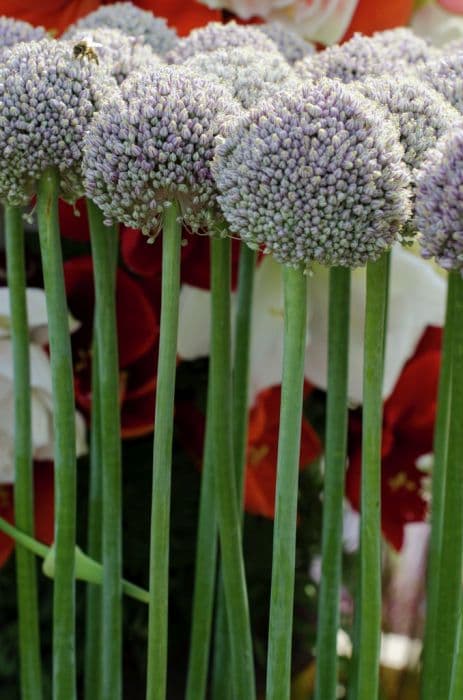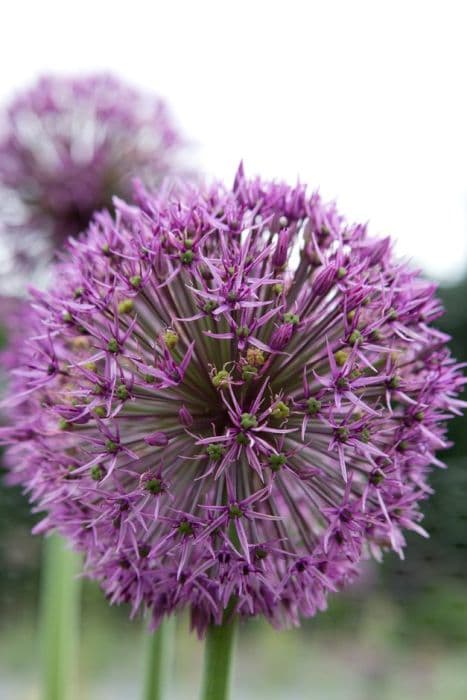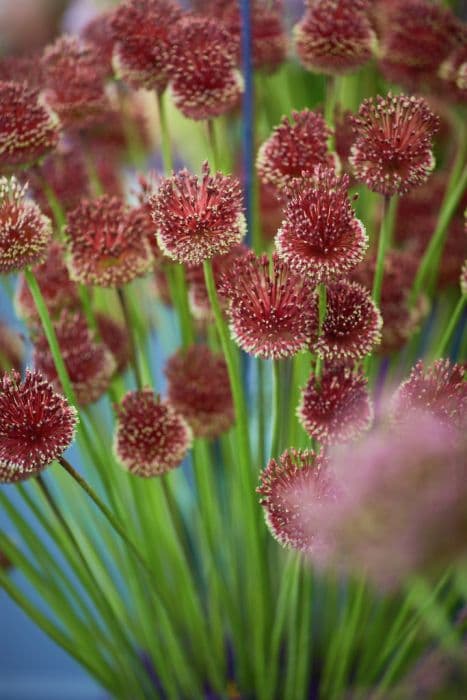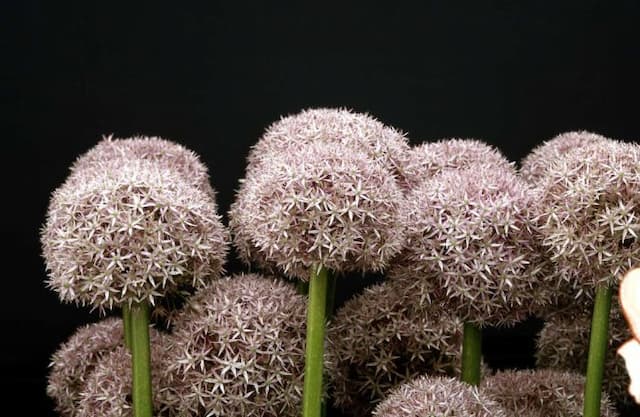Maclean's Garlic Allium macleanii

ABOUT
Allium macleanii, commonly known as Maclean's garlic, is a perennial plant that exhibits a striking appearance often admired in gardens and landscapes. It is characterized by its lush, strap-shaped green leaves that typically grow in a clumping fashion. The foliage of Maclean's garlic provides a verdant background for the eye-catching flowers that emerge on top. The most distinct feature of Maclean's garlic is its spherical flower head, which is made up of numerous small, star-shaped flowers that are tightly clustered together. These blooms are usually a shade of lilac or sometimes a purplish-pink, adding a splash of color and a touch of whimsy to the plant's overall presentation. The flowers are borne on sturdy, upright stems that rise from the base of the plant. The stems themselves are smooth and green, blending seamlessly into the background foliage. The contrast between the color of the flowers and the green stems creates a pleasing aesthetic that is appealing to many garden enthusiasts. In terms of its root system, Maclean's garlic typically develops a network of underground bulbs, from which the leaves and flower stalks emerge. These bulbs not only support the life of the plant year after year but also contribute to its propagation, as they can be divided and replanted to produce new plants. Throughout the blooming season, Maclean's garlic can attract various pollinators, including bees and butterflies, which are drawn to the nectar-rich flowers. The presence of these pollinators adds another layer of interest and vitality to the plant's appearance. In summary, Maclean's garlic is a captivating plant with lush foliage and charming, round flower heads composed of small, colorful blooms, all lifted by slender stems that create an elegant and attractive presence in any suitable garden setting.
About this plant
 Names
NamesFamily
Amaryllidaceae
Synonyms
Maclean's Garlic, Broadleaf Wild Leek
Common names
Allium elburzense Regel, Allium haussknechtii Regel, Allium regelii Trautv.
 Toxicity
ToxicityTo humans
Allium macleanii, commonly known as the wild onion, is not considered highly toxic to humans. Members of the Allium family can be eaten in moderate amounts as food. However, excessive consumption can lead to symptoms such as gastrointestinal irritation or discomfort due to the presence of various sulfur-containing compounds. It is always recommended to consume plants that are positively identified and deemed safe by trusted sources.
To pets
Allium macleanii, which is commonly known as the wild onion, can be toxic to pets, especially cats and dogs. If a pet ingests wild onion, it can cause symptoms like vomiting, diarrhea, abdominal pain, and in severe cases, oxidative damage to red blood cells leading to hemolytic anemia. This condition may result in symptoms like lethargy, pale gums, rapid breathing, and ataxia. If you suspect your pet has ingested this plant, it is important to seek veterinary care immediately.
 Characteristics
CharacteristicsLife cycle
Perennials
Foliage type
Deciduous
Color of leaves
Green
Flower color
Pink
Height
3 feet (0.91 meters)
Spread
1 foot (0.3 meters)
Plant type
Bulb
Hardiness zones
5
Native area
Central Asia
Benefits
 General Benefits
General Benefits- Culinary Usage - Allium macleanii, commonly known as wild onion, can be used in cooking for its onion-like flavor.
- Gardening Interest - With its attractive flowers, it can add visual aesthetic to gardens and landscapes.
- Pollinator Attraction - The plant is known to attract bees, butterflies, and other beneficial pollinators.
- Low Maintenance - Wild onion generally requires minimal care once established, making it a good choice for low-maintenance gardens.
- Drought Tolerance - This species can withstand dry conditions, making it suitable for xeriscaping or areas with water restrictions.
- Cultural Significance - In certain cultures, Allium macleanii may hold traditional significance in terms of heritage and culinary practices.
 Medical Properties
Medical Properties- Antibacterial: Allium macleanii may possess antibacterial properties due to the presence of certain sulfur compounds.
- Antioxidant: This plant could have antioxidant effects, thus potentially helping to neutralize harmful free radicals in the body.
- Anti-inflammatory: There may be anti-inflammatory compounds present in Allium macleanii that could help reduce inflammation.
 Air-purifying Qualities
Air-purifying QualitiesThis plant is not specifically known for air purifying qualities.
 Other Uses
Other Uses- Allium macleanii bulbs can be used as a natural adhesive. The juice from the crushed bulbs can be applied to paper and small items to stick them together.
- The leaves of the Allium macleanii, also known as the Maclean's garlic, can be used to create a natural green dye for fabrics and wool.
- Crushed bulbs may serve as a natural pest deterrent when spread around plants susceptible to insects and critters due to their strong scent.
- The stems can be woven into baskets or mats, utilizing their structural integrity when dried.
- The flowers can be used for decorative purposes in dried flower arrangements, maintaining their shape and color for extended periods.
- The stout stems can also be used as natural skewers for grilling, infusing a subtle garlic flavor into meats and vegetables.
- Extracts from the plant may be used in perfumery to add a distinctive and earthy aroma to fragrances.
- The seed heads of the Maclean's garlic, once dried, can be used as a part of flower arrangements or even as natural rattles in crafts.
- The fibrous parts of the plant can be used in the making of paper, providing texture and interest when included in handmade paper goods.
- When planted in a garden, Allium macleanii can act as a companion plant, possibly deterring certain pests from more vulnerable plants due to its strong scent and taste.
Interesting Facts
 Feng Shui
Feng ShuiThe Allium macleanii, commonly known as Maclean's Garlic, is not used in Feng Shui practice.
 Zodiac Sign Compitability
Zodiac Sign CompitabilityThe Maclean's Garlic is not used in astrology practice.
 Plant Symbolism
Plant Symbolism- Strength: Alliums, known often as ornamental onions, have sturdy stems, representing resilience and inner strength.
- Prosperity: The globular blooms of the Allium macleanii resemble coins, which can symbolize wealth and prosperity.
- Unity: The tight clusters of flowers on the spherical heads symbolize togetherness and unity.
- Protection: In folklore, Alliums are believed to ward off evil spirits and are often planted to protect other plants, symbolizing a protective nature.
- Perseverance: Allium macleanii, as a hardy plant, reflects the ability to withstand hardships and keep going.
 Water
WaterMaclean's garlic requires moderate watering, and it's essential not to overwater as it prefers well-drained soil. Water thoroughly once a week, providing about an inch of water, which is equivalent to approximately 0.6 gallons per square yard of soil area. During the active growing season in spring and early summer, you can increase watering if there are signs of dry soil, but always allow the top inch of soil to dry out between watering sessions. Cut back on watering once the leaves begin to yellow and die back in late summer, as the plant is entering dormancy.
 Light
LightMaclean's garlic thrives in full sun conditions. The ideal spot is an area that receives at least six hours of direct sunlight per day. Avoid planting it in shaded areas, as insufficient light can lead to poor growth and reduced flowering. Full sun exposure will ensure the best growth and bloom performance for Maclean's garlic.
 Temperature
TemperatureMaclean's garlic does well in a wide range of temperatures, but it prefers the cooler end of the spectrum. It can survive minimum temperatures down to about 15°F, while the ideal growing range is between 60°F and 75°F. Maclean's garlic is quite hardy and can tolerate brief periods of higher temperatures, but prolonged heat can be detrimental.
 Pruning
PruningMaclean's garlic requires minimal pruning. Deadheading the spent flowers after blooming can encourage more vigorous growth and can be done throughout the blooming period. Pruning is generally done after flowering, and no specific pruning technique is required other than the removal of spent flower stalks and any yellowing foliage that occurs naturally at the end of the growing season.
 Cleaning
CleaningAs needed
 Soil
SoilFor Maclean's Garlic (Allium macleanii), prepare a well-draining soil mix with compost, perlite, and sand to facilitate good drainage and avoid water-logging. The ideal soil pH for this plant should be between 6.0 to 7.5, which is slightly acidic to neutral.
 Repotting
RepottingMaclean's Garlic should be repotted every two to three years, or when it has outgrown its current pot. It's best to do this repotting in the fall after the foliage has died back.
 Humidity & Misting
Humidity & MistingMaclean's Garlic thrives best in outdoor conditions where it can receive natural atmospheric humidity. It does not require high humidity levels and is generally tolerant of the humidity found in most temperate climates.
 Suitable locations
Suitable locationsIndoor
Place in south-facing window, water sparingly, no extra humidity.
Outdoor
Full sun, well-drained soil, water when dry, hardy outdoors.
Hardiness zone
5-8 USDA
 Life cycle
Life cycleAllium macleanii, commonly known as Maclean's garlic, begins its life cycle when seeds germinate in autumn or early spring, developing small roots and shoots. The juvenile stage is characterized by the emergence of slender, green leaves that grow upwards. As the plant matures, a sturdy stalk elongates, leading to the formation of a spherical cluster of star-shaped flowers, typically by late spring or early summer. After the flowering stage, pollination occurs, often with the help of insects, resulting in the development of seed capsules. Following seed maturation, the plant begins to senesce; the foliage yellows and the aerial parts die back, while the bulb enters a period of dormancy. With the arrival of the next conducive growth season, the cycle restarts as the dormant bulb sprouts new foliage, resuming the growth process.
 Propogation
PropogationPropogation time
Spring
Propogation: Allium macleanii, commonly known as Maclean's garlic, is often propagated by dividing its bulbs. The best time to propagate is in the fall after the foliage has died back. To propagate by bulb division, carefully lift the clump of bulbs out of the soil using a garden fork to avoid damaging them. Gently separate the individual bulbs from the clump, ensuring each bulb has a portion of the basal plate to produce roots. Replant the bulbs at a depth of about 3 inches (about 7.6 cm) and a spacing of 6-8 inches (about 15-20 cm) apart, choosing a location with well-draining soil and full sun to partial shade. Water the newly planted bulbs moderately to help establish them. This vegetative method of propagation ensures that the offspring will be genetically identical to the parent plant.









